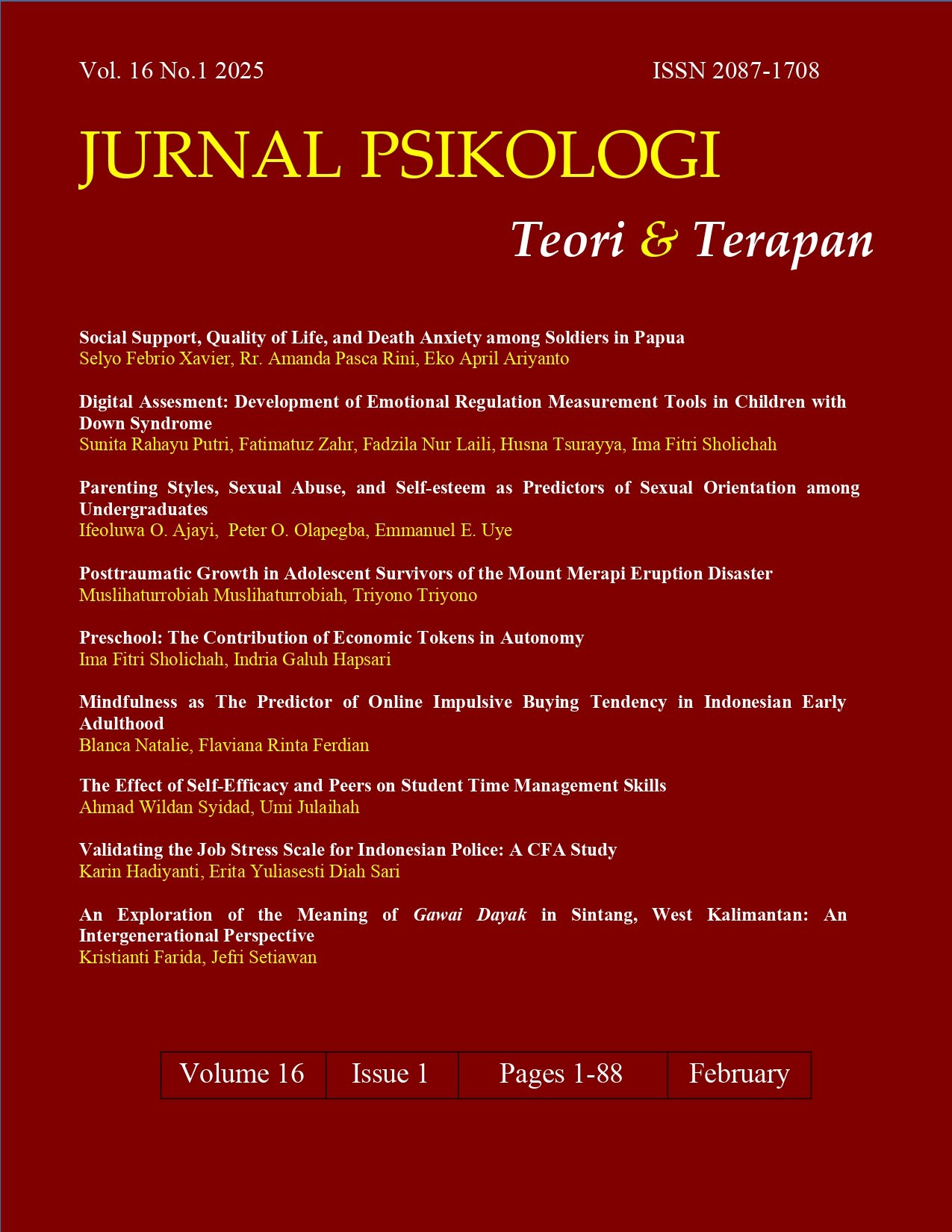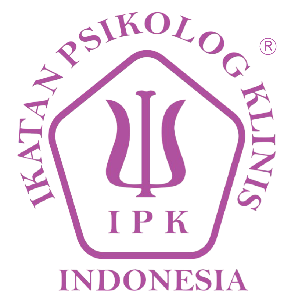An Exploration of the Meaning of Gawai Dayak in Sintang, West Kalimantan: An Intergenerational Perspective
DOI:
https://doi.org/10.26740/jptt.v16n01.p77-88Keywords:
Cultural identity, cultural preservation, gawai dayak, inter generational perception, modernity and traditionAbstract
Background: The Gawai Dayak tradition represents a cultural practice encompassing a range of spiritual, social, and symbolic values passed down through generations in Dayak society. However, due to the impact of modernity, the meaning and significance of Gawai Dayak have shifted, especially among the traditional leader group and the younger generation group. Objective: This research aims to examine the intergenerational perceptions of the Gawai Dayak tradition, focusing on how these cultural values are perceived, revered, and conveyed amidst the challenges posed by modernity. Method: This study employed a qualitative design with a realism approach. Data collection was conducted through in-depth interviews with two former sub-district-level adat leaders and one Dara Gawai winner from the Sintang district. In addition, a questionnaire with open-ended questions was distributed to nine individuals aged 19-23, representing the younger generation. Thematic analysis was used to analyze the data, involving transcribing the data verbatim, categorizing it into codes, and organizing it into themes. Data credibility and authenticity were ensured using triangulation and member checking. Results: The study reveals a generational difference in the interpretation of Gawai Dayak, with the traditional leaders emphasizing its spiritual and ritual significance, while the younger generation views it more as a celebration, especially concerning alcohol consumption and rituals. Conclusion: Gawai Dayak holds different meanings across generations. Traditional leaders emphasize its spiritual aspects, while the younger generation focuses on its festive nature. These findings highlight the need for intergenerational transmission of cultural values. This research suggests the importance of preserving traditional values within communities.
Keywords: Cultural identity, cultural preservation; gawai dayak; inter generational perception; modernity and tradition.
Abstrak
Tradisi Gawai Dayak merupakan praktik budaya yang mencakup berbagai nilai spiritual, sosial, dan simbolis yang diwariskan dari generasi ke generasi dalam masyarakat Dayak. Makna dan arti penting Gawai Dayak telah bergeser, terutama di antara kelompok pemimpin adat dan generasi muda. Tujuan: Penelitian ini bertujuan untuk mengkaji persepsi antargenerasi tentang tradisi Gawai Dayak, dengan fokus pada bagaimana nilai-nilai budaya tersebut dipersepsikan, dihormati, dan disampaikan di tengah-tengah tantangan yang ditimbulkan oleh modernitas. Metode: Penelitian ini menggunakan desain kualitatif dengan pendekatan realisme. Pengumpulan data dilakukan melalui wawancara mendalam dengan dua mantan ketua adat tingkat kecamatan dan satu pemenang Dara Gawai dari Kabupaten Sintang. Selain itu, kuesioner dengan pertanyaan terbuka dibagikan kepada sembilan orang berusia 19-23 tahun yang mewakili generasi muda. Analisis tematik digunakan untuk menganalisis data, yang melibatkan transkrip data kata demi kata, mengkategorikannya ke dalam kode-kode, dan mengorganisasikannya ke dalam tema-tema. Kredibilitas dan keaslian data dipastikan dengan menggunakan triangulasi dan pengecekan partisipan. Hasil: Penelitian ini mengungkapkan perbedaan generasi dalam interpretasi Gawai Dayak, dengan para pemimpin adat menekankan makna spiritual dan ritualnya, sementara generasi muda lebih melihatnya sebagai perayaan, terutama terkait konsumsi alkohol dan ritual. Kesimpulan: Gawai Dayak memiliki makna yang berbeda di setiap generasi. Para pemimpin adat menekankan aspek spiritualnya, sementara generasi muda berfokus pada sifat perayaannya. Temuan ini menyoroti perlunya transmisi nilai-nilai budaya antargenerasi. Penelitian ini menunjukkan pentingnya melestarikan nilai-nilai tradisional dalam masyarakat.
Kata kunci: Gawai dayak; identitas budaya; persepsi antargenerasi; pelestarian budaya; modernitas dan tradisi.
References
Adelbertus Beato Yulandi, F.X. Eko Armada Riyanto, & Mathias Jebaru Adon. (2023). Gawai Dayak Sebagai Kearifan Lokal Pelopor Integritas Dan Solidaritas Masyarakat Suku Dayak Lebang. SABANA: Jurnal Sosiologi, Antropologi, Dan Budaya Nusantara, 2(3), 159–170. https://doi.org/10.55123/sabana.v2i3.2966
Alfikar, G., Santi, D., & Yosi, V. (2018). Mempertahankan Eksistensi Budaya Lokal Nusantara Ditengah Arus Globalisasi Melalui Pelestarian Tradisi Gawai Dayak Sintang. JURNAL PEKAN: Jurnal Pendidikan Kewarganegaraan 3(1), 43–56. https://doi.org/10.31932/jpk.v3i1.144
Asyhar, S. (2016). Konformitas Pada Perilaku Minum-Minuman Keras (Pengasih) Pada Remaja Suku Dayak Berusu. Psikoborneo: Jurnal Ilmiah Psikologi, 4(4). https://doi.org/10.30872/psikoborneo.v4i4.4235
Bahri, S. (2015). Gawai Dayak sebagai Sumber Sejarah Lokal Tradisi Masyarakat Indonesia Sebelum Mengenal Tulisan. SOCIA: Jurnal Ilmu-Ilmu Sosial, 12(2). https://doi.org/10.21831/socia.v12i2.12236
Chirkov, V. I., Ryan, R. M., & Willness, C. (2005). Cultural Context and Psychological Needs in Canada and Brazil: Testing a Self-Determination Approach to the Internalization of Cultural Practices, Identity, and Well-Being. Journal of Cross-Cultural Psychology, 36(4), 423–443. https://doi.org/10.1177/0022022105275960
Church, A. T., Katigbak, M. S., Locke, K., Zhang, H.-S., Shen, J., De Jesus Vargas-Flores, J., IbsnEz-Reyes, J., Tanaka-Matsumi, J., Curtis, G. J., Cabrera, H. F., Mastor, K. A., Alvarez, J. M., Ortiz, F. A., Simon, J.-Y. R., & Ching, C. M. (2012). Need Satisfaction and Well-Being: Testing Self-Determination Theory in Eight Cultures: (642572012-001) [Dataset]. https://doi.org/10.1037/e642572012-001
Clark, K. J., & Coe, K. (2021). The interdependence of ancestors and their descendants. Religion, Brain & Behavior, 11(3), 281–293. https://doi.org/10.1080/2153599X.2021.1922494
Davoren, M. P., Cronin, M., Perry, I. J., Demant, J., Shiely, F., & O’Connor, K. (2016). A typology of alcohol consumption among young people – A narrative synthesis. Addiction Research & Theory, 24(4), 261–273. https://doi.org/10.3109/16066359.2015.1121244
Djunaid, I. S., Fahlevi, R., Sinambela, F. A., Djati, S. P., & Nurbaeti, N. (2024). Tinjauan Ontologi Pekan Gawai Dayak Sebagai Daya Tarik Wisata Budaya di Kota Pontianak: -. JIIP - Jurnal Ilmiah Ilmu Pendidikan, 7(3), 2629–2637. https://doi.org/10.54371/jiip.v7i3.3946
Deci, E. L., & Ryan, R. M. (1985). The general causality orientations scale: Self-determination in personality. Journal of Research in Personality, 19(2), 109–134. https://doi.org/10.1016/0092-6566(85)90023-6
Deci, E. L., & Ryan, R. M. (2000). The “What” and “Why” of Goal Pursuits: Human Needs and the Self-Determination of Behavior. Psychological Inquiry, 11(4), 227–268. https://doi.org/10.1207/S15327965PLI1104_01
Efriani, E., Rohilie, H. F. ., Sihaloho, N. T. P. ., & Varanida, D. (2021). Pamole’ Beo’: Pesta syukur padi petani ladang Dayak Tamambaloh di Kalimantan Barat. Satwika : Kajian Ilmu Budaya Dan Perubahan Sosial, 5(2), 229–240. https://doi.org/10.22219/satwika.v5i2.17938
Elyta, E. (2021). Gawai dayak festival and the increase of foreign tourist visits. Jurnal Global &Amp; Strategis, 15(1), 167. https://doi.org/10.20473/jgs.15.1.2021.167-186
Fahmi, M. R. and Muhyiddin, A. (2023). The existence of kaharingan within dayak identity in west kalimantan. Al-Albab, 12(1), 113-132. https://doi.org/10.24260/alalbab.v12i1.2662
Fatma Wati, D., & Ardelia, V. (2023). ”Gawai Dayak”: Tradisi setelah masa panen sebagai wujud Pluralisme dalam masyarakat di Bumi Sebaloh . Innovative: Journal Of Social Science Research, 3(5), 3141–3154. http://j-innovative.org/index.php/Innovative/article/view/5125
Fusnika, F., & Dua, F. L. (2019). Kontribusi Budaya Lokal Gawai Dalam Menumbuhkan Nilai Solidaritas Generasi Z Pada Suku Daya Mualang. JURNAL PEKAN : Jurnal Pendidikan Kewarganegaraan, 4(2), 149–158. https://doi.org/10.31932/jpk.v4i2.554
Gauvain, M. (2005). Scaffolding in socialization. New Ideas in Psychology, 23(3), 129–139. https://doi.org/10.1016/j.newideapsych.2006.05.004
Ghassemzadeh, H. (2005). Vygotsky’s mediational psychology: A new conceptualization of culture, signification and metaphor. Language Sciences, 27(3), 281–300. https://doi.org/10.1016/j.langsci.2004.04.003
Hariyanti, Y. D., & Anggara, O. F. (2023). Tradisi Gawai sebagai Pendorong Kohesi Sosial bagi Masyarakat Suku Dayak Kalimantan Barat. Ideas: Jurnal Pendidikan, Sosial, dan Budaya, 9(4), 1135. https://doi.org/10.32884/ideas.v9i4.1542
Helana, H., Bahari, Y., Ismiyani, N., & Haqjo, S. (2023). Analysis Of Naik Dango Tradition Values In The Dayak Kanayatn Ethnicity In Bandang Hamlet. Jurnal Pendidikan Sosiologi dan Humaniora, 14(2), 322-331. https://doi.org/10.26418/j-psh.v14i2.63608
Herlan, H. and Elyta, E. (2020). Model of gawai dayak based-social capital in the border of sajingan besar of west kalimantan. Sosiohumaniora, 22(1). https://doi.org/10.24198/sosiohumaniora.v22i1.26042
Kencana, J. P., & Marianta, Y. I. W. (2023). Peran Kaum Muda Desa Labang Dalam Upaya Pelestarian Budaya Suku Dayak Kebahan Dalam Perspektif Evring Goffman. Jurnal Budaya Nusantara 6(1), 214–220. https://doi.org/10.36456/JBN.vol6.no1.6430
Lincoln, YS dan Guba, EG (1985) Naturalistic Inquiry. SAGE, Thousand Oaks, 289-331. https://dx.doi.org/10.1016/0147-1767(85)90062-8
Marselus, M., Siswandi, S., & Nur, S. (2023). Pewarisan Nilai-nilai Kearifan Lokal Dalam Upacara Gawai Dayak Pada Masyarakat Suku Dayak Bakati Untuk Meningkatkan Kepedulian Sosial Siswa SMP Negeri 2 Bengkayang. Sosial Horizon: Jurnal Pendidikan Sosial, 10(2), 209–219. https://doi.org/10.31571/sosial.v10i2.6770
Mermelshtine, R. (2017). Parent–child learning interactions: A review of the literature on scaffolding. British Journal of Educational Psychology, 87(2), 241–254. https://doi.org/10.1111/bjep.12147
Morin, O. (2018). Cultural Transmission. In H. Callan (Ed.), The International Encyclopedia of Anthropology (1st ed., pp. 1–10). Wiley. https://doi.org/10.1002/9781118924396.wbiea1882
Munawaroh, C., & Setyawan, J. (2024). “Andhap Asor” in a Psychological Perspective: A Realist Study of Contemporary Javanese Society. Jurnal Psikologi Teori Dan Terapan, 15(03), 284–293. https://doi.org/10.26740/jptt.v15n03.p284-293
Peterianus, S., & Mastiah, M. (2020). Eksistensi Suku Dayak Seberuang Menghadapi Tekanan Modernisasi Melalui Ritual Gawai Dayak. Bestari: Jurnal Pendidikan dan Kebudayaan, 1(2), 36–43. https://doi.org/10.46368/bjpd.v1i2.207
Purwiati, H. (2020). Nilai Budaya Dan Eksistensi Sastra Lisan Dayak Golik Di Kabupaten Sanggau. tuahtalino, 14(2), 173. https://doi.org/10.26499/tt.v14i2.2354
Rengat, I. S., Ronaldo, P., & Hexano, S. A. D. (2022). Upacara Adat Gawai Suku Dayak Kalbar sebagai Kearifan Lokal dan Pembentuk Nilai Solidaritas. Titian: Jurnal Ilmu Humaniora, 6(2), 182–193. https://doi.org/10.22437/titian.v6i2.21080
Restoeningroem, R., Ati, A. P., Widiyarto, S., & Suyana, N. (2023). The Value of Dayak Gawai Tradition: Learning Kantu’Dayak Literature. AL-ISHLAH: Jurnal Pendidikan, 15(4), 6671-6678. https://doi.org/10.35445/alishlah.v%25vi%25i.2752
Revaldi, M., Faridah, S., & Musfichin, M. (2024). Prosocial behavior in the dayak ethnicity in central kalimantan province. Winter Journal: Imwi Student Research Journal, 4(2), 166-173. https://doi.org/10.52851/wt.v4i2.58
Rivasintha, E., & Juniardi, K. (2017). Pergeseran Nilai-nilai Budaya Dalam Upacara Adat Gawai Dayak Ditinjau Dari Sosial Ekonomi Masyarakat Kota Pontianak. Sosial Horizon: Jurnal Pendidikan Sosial 4(1), pp. 1–10. https://doi.org/10.31571/sosial.v4i1.418
Schwartz, S. H. (2012). An Overview of the Schwartz Theory of Basic Values. Online Readings in Psychology and Culture, 2(1). https://doi.org/10.9707/2307-0919.1116
Sobh, R., & Perry, C. (2006). Research design and data analysis in realism research. European Journal of Marketing, 40(11/12), 1194–1209. https://doi.org/10.1108/03090560610702777
Suswandari, S., Armiyati, L., & Azid, N. (2022). Local wisdom of dayak ethnic groups in central kalimantan, Indonesia. ETNOSIA : Jurnal Etnografi Indonesia, 7(1), 67–85. https://doi.org/10.31947/etnosia.v7i1.20633
Suwartiningsih, S., Samiyono, D., & Purnomo, D. (2018). Harmonisasi Sosial Masyarakat Perbatasan Indonesia-Malaysia. Jurnal Hubungan Internasional, 7(1). https://doi.org/10.18196/hi.71120
Syafrita, I., & Murdiono, M. (2020). Upacara Adat Gawai Dalam Membentuk Nilai-Nilai Solidaritas Pada Masyarakat Suku Dayak Kalimantan Barat. Jurnal Antropologi: Isu-Isu Sosial Budaya, 22(2), 151. https://doi.org/10.25077/jantro.v22.n2.p151-159.2020
Triandis, H. C., Bontempo, R., Betancourt, H., Bond, M., Leung, K., Brenes, A., Georgas, J., Hui, C. H., Marin, G., Setiadi, B., Sinha, J. B. P., Verma, J., Spangenberg, J., Touzard, H., & Montmollin, G. D. (1986). The measurement of the etic aspects of individualism and collectivism across cultures. Australian Journal of Psychology, 38(3), 257–267. https://doi.org/10.1080/00049538608259013
Widiyarto, S. (2023). Pembelajaran Sastra Bersumber dari Tradisi Lisan Gawai Dayak Kalimantan Barat. Wacana : Jurnal Bahasa, Seni, dan Pengajaran, 7(2), 185–190. https://doi.org/10.29407/jbsp.v7i2.21625
Yusriadi, Y., Munawar, M., Agustini, H., Muttaqin, I., Mujiono, M., & Ichwan, F. (2023). University and the narrative of ethno-religious relations in west kalimantan. Al-Hayat: Journal of Islamic Education, 7(2), 305. https://doi.org/10.35723/ajie.v7i2.373
Downloads
Published
How to Cite
Issue
Section
License
Copyright (c) 2025 Kristianti Farida, Jefri Setiawan

This work is licensed under a Creative Commons Attribution 4.0 International License.
Authors who publish in this journal agree to the following terms:
Copyright in any article is held by the author.
The author grants the journal, publication rights with the work simultaneously licensed under a Creative Commons Attribution License that allows others to share the work with an acknowledgment of the work's authorship and initial publication in this journal.
Authors may enter into separate, additional contractual arrangements for the non-exclusive distribution of the journal's published version of the work (e.g., posting it to an institutional repository or publishing it in a book), with an acknowledgment of its initial publication in this journal.
Authors are permitted and encouraged to post their work online (e.g., in an institutional repository or on their website) prior to and during the submission process, as this can lead to productive exchanges, as well as earlier and greater citation of published work.
 Abstract views: 392
,
Abstract views: 392
, PDF Downloads: 242
PDF Downloads: 242


















